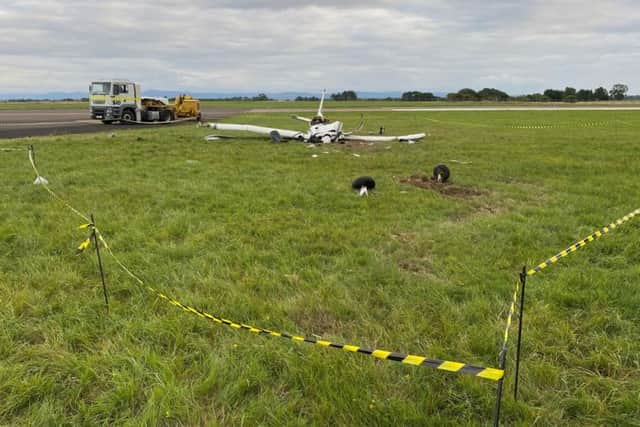Three injured in plane crash when pilot attempted to turn back after engine fault
The Grumman AA-5 aircraft crash landed in a field next to a runway at Teesside International Airport, 67 seconds after takeoff, on September 21 last year.
The Air Accidents Investigation Branch (AAIB) found a mechanical fault caused partial power loss and when the pilot attempted to turn back and land on a runway, the plane stalled.
Advertisement
Hide AdAdvertisement
Hide AdAfter the crash, an air ambulance was called all three people who were on board the plane were taken to hospital for treatment.


The AAIB said the aircraft, which had recently returned from an annual maintenance inspection, started up normally and was cleared for takeoff at 8.34am.
The 63-year-old pilot, who was in hospital for several months after the crash, said he realised the engine had lost power at around 400 feet above ground level, but he could not bring the plane straight back down onto the runway or land in the field ahead of him, as it was full of animals, farm vehicles and people.
He said he ran through the eight-point engine failure checklist and then turned back to land on another runway, but realised he was flying too low to reach it and spotted a patch of grass which “looked good enough” to land on.
Advertisement
Hide AdAdvertisement
Hide AdThe pilot told investigators he would not have normally considered this difficult manoeuvre, but he had successfully practised it three times the previous year.
The investigation found that landing on the same runway he took off from “would have been possible” but this “would not have been immediately evident to the pilot”.
It also found the plane would need to have travelled at atleast 71mph, to successfully turn back at that angle and avoid stalling, but it was moving at just 64mph.
An examination of the engine revealed a piece of accelerator pump discharge tube broke off and was sucked into one of the cylinders. This caused the partial loss of power.
Advertisement
Hide AdAdvertisement
Hide AdA report on the investigation stated: “A lack of practice at conducting turnback manoeuvres would have made the pilot’s workload extremely high. He was using a high angle of bank, close to the ground at low speeds whilst under significant pressure.
“His workload was further increased by conducting the engine failure checklist. These factors would have made a successful turnback with very limited power extremely challenging.
“It is likely that the attention of the pilot became focussed on achieving the required turn to reach his selected landing area and that he did not adjust the airspeed to avoid the accelerated stall.”
The AAIB also stated the UK Civil Aviation Authority should begin providing detailed guidance on techniques for managing partial power loss and encourage instructors and examiners to teach these techniques.
Advertisement
Hide AdAdvertisement
Hide AdIt said a lack of information and training in the UK means it is currently "not straightforward for pilots to prepare themselves appropriately" to deal with this situation.
Since 2011, it has conducted investigations into 16 crashes involving loss of power, which have resulted in 15 deaths and nine serious injuries.
In those cases, there were five attempted turnbacks and all of them resulted in fatalities or injuries.
